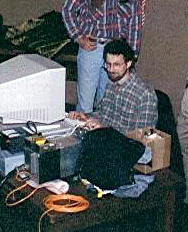David Rabinowitz
| David Lincoln Rabinowitz | |
|---|---|

David Lincoln Rabinowitz working at the NEAT-Project
|
|
| Born | 1960 (age 56–57) |
| Fields | Astrophysics |
| Institutions |
Yale University's Center for Astronomy and Astrophysics University of Arizona Lunar and Planetary Laboratory |
| Alma mater | Yale University University of Chicago |
| Thesis | Joint Convolutional and Orthogonal Decoding of Interleaved-Data Frames for IS-95 CDMA Communications (1996) |
| Known for | Co-discoverer of the new population of dwarf planets in the outer solar system |
|
Website physics |
|
David Lincoln Rabinowitz (born 1960) is an American astronomer, discoverer of minor planets and researcher at Yale University.
He has built CCD cameras and software for the detection of near-Earth and Kuiper belt objects, and his research has helped reduce the assumed number of near-Earth asteroids larger than 1 km by half, from 1,000–2,000 to 500–1,000 He has also assisted in the detection of distant solar system objects, supernovae, and quasars, thereby helping to understand the origin and evolution of the solar system and the dark energy driving the accelerated expansion of the universe.
Collaborating with Michael Brown and Chad Trujillo of the Quasar Equatorial Survey Team, he has participated in the discovery of several plutoids such as 90377 Sedna (possibly the first known inner Oort cloud object), 90482 Orcus,Eris (more massive than Pluto), Haumea, and Makemake, although he would not get credit for Haumea.
Together with Tom Gehrels of the University of Arizona and his Spacewatch team, Rabinowitz discovered or co-discovered other astronomical objects including 5145 Pholus (credited by the MPC to Spacewatch) and 1991 BA (uncredited yet).
...
Wikipedia
